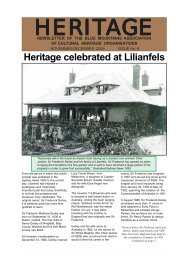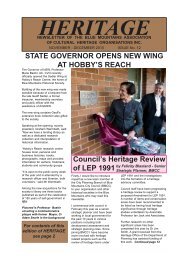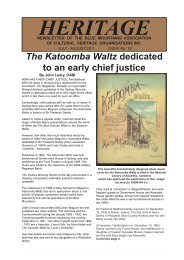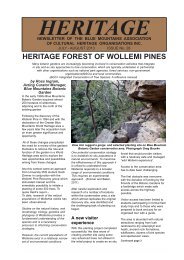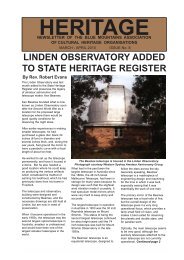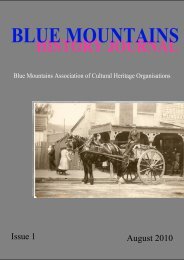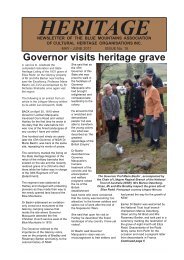Blue Mountains History Journal Issue 2
Blue Mountains History Journal Issue 2
Blue Mountains History Journal Issue 2
Create successful ePaper yourself
Turn your PDF publications into a flip-book with our unique Google optimized e-Paper software.
<strong>Blue</strong> <strong>Mountains</strong> <strong>History</strong> <strong>Journal</strong> 2; 2011<br />
A W.R.J. 'Jack' Scott (Moore 1989,<br />
Fig. 4, between p.134 & 135;<br />
Douglas 2004, p.6)<br />
B Sir Philip Goldfinch (Moore 1989,<br />
Fig. 7? (not numbered), between<br />
p.134 & 135)<br />
Figure 1.<br />
A Sir Robert Gillespie (Knox<br />
Grammar School 2011)<br />
Figure 2.<br />
B Colonel Erik Campbell 1931<br />
(Campbell 1965, opp. p.74)<br />
form what eventually became the United Australia Party (Macintyre 1999, p.179). All three<br />
organizations had a presence in the <strong>Blue</strong> <strong>Mountains</strong> and the country organizer for the ‘All For<br />
Australia League’ was John McManamey, principal of Woodford Academy.<br />
Major General Sir Charles Rosenthal, another <strong>Blue</strong> <strong>Mountains</strong> resident, had links with an earlier<br />
conservative organisation known as ‘The King and Empire Alliance’ (Cathcart 1988, p.96). It is<br />
commonly held that the novel Kangaroo, written by D.H. Lawrence, was based on the formation of a<br />
secret paramilitary army in New South Wales, and the main character, Kangaroo, is said to have<br />
been based on Rosenthal, while the character Jack Callcott was based on Jack Scott (Lawrence 1923,<br />
pp.160-161). The Old Guard shared many similarities to The King and Empire Alliance because<br />
both organisations were comprised of many ex-army officers.<br />
52 Back to Contents




